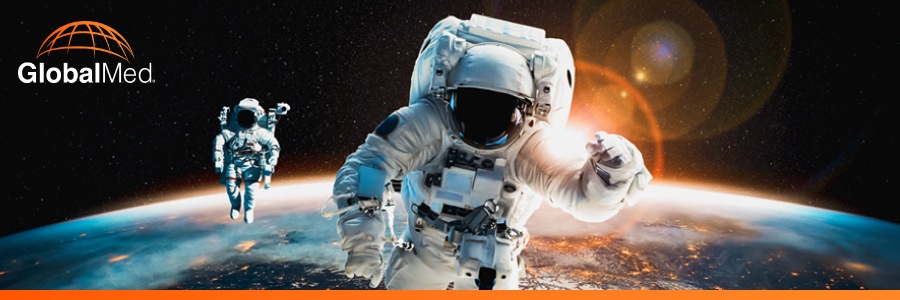
If you’ve ever stood in your backyard on a summer night and looked up at the glittering cosmos – or debated the merits of Star Trek’s USS Enterprise vs. Star War’s Millennium Falcon – you’ve probably wondered how far we’ll penetrate the mysteries of space in our lifetime. In some ways, it seems the impossible dream. But Dr. Marc O Griofa believes that we could expand our cosmic achievements within this century, with telemedicine playing an important role.
“The history of humankind is punctuated by periods of exploration that almost define who we are,” he says. “Going beyond our planet is at the core of our DNA, from Christopher Columbus to Neil Armstrong and many other exploration pioneers. Without pushing the outside of the edge of the envelope, we become stagnant as a species. Space exploration is an integral part of human development, both now and in the future – and telemedicine must be an integral part of space exploration as we support these crews who will venture further and further from Earth.”
Meet Dr. O Griofa, a physician and engineer who has led a variety of projects with the Space Shuttle program, the International Space Station, the U.S, Veterans Hospital Administration and U.S. Department of Defense. He talked to GlobalMed about why telemedicine is creating a paradigm shift in medicine, how it’s being used during current spaceflight missions and why it plays an important role in expanding our capacity for spaceflight beyond low earth orbit.
Turning Science Fiction into Science Fact
Dr. O Griofa is the principal investigator in the first Irish experiment to fly onboard ISS; he spent several years as a triage doc for the Space Shuttle Program at Kennedy Space Center. He also specializes in teaching and training combat medicine and battlefield trauma for military and Special Operations Forces units.
Those interests have focused on a career in emergency and prehospital medicine, but have also included being a part of the team that successfully completed the first double lung transplant surgery in Ireland. Dr. O Griofa, a tactical physician with the Las Vegas Metropolitan Police Department SWAT Team who’s trained both U.S. and International Special Operation Forces in combat medicine, quickly discovered the value of telemedicine in extreme conditions.
“If someone is injured in Afghanistan, medics in the field have a short time to treat them before a gunshot wound becomes septic or organs start to shut down,” he says. “Telemedicine creates a conduit from the field to a provider or surgeon on the other end, especially in instances of prolonged field care or emergency surgical procedures.”
Beyond emergency medicine, Dr. O Griofa believes that virtual care is essential to solving current barriers to care.
“Telemedicine is going to change face of healthcare,” he predicts. “Right now healthcare is a black hole. You could pump in a billion dollars and find very few of those dollars will touch an individual patient. We need to rethink our approach. Otherwise the industry will collapse under its own weight. Telemedicine can create a paradigm shift that’s not just necessary but incumbent on everyone who practices medicine.”
Noting the evolution of telemedicine capabilities, Dr. O Griofa sees parallels between robotic surgery and telemedicine. “There were pitfalls and improvements that came along with robotic surgery,” he says. “It was such a huge leap forward, what we could do without being physically in the surgical theatre with the patient. Even 20 years ago, it seemed like science fiction. Now that we’re using telemedicine in so many disruptive ways, I see the same leaps and bounds in innovation. I think telemedicine will drive the industry forward in the most fundamental way for years to come and change the face of healthcare in the process.”
“Science fiction has become science fact,” he says.
From the Ocean Floor to the Moon
Dr. O Griofa’s expertise led him to working with the Space Shuttle’s triage and trauma team at Kennedy Space Center. A trained diving medical officer and avid diver, he then applied his research and background to NASA’s Extreme Environment Mission Operations (NEEMO) Program, onboard the Aquarius Undersea Habitat, which is an underwater research station off the Florida Keys. Here astronauts and aquanauts train underwater for future spaceflight missions – using this extreme environment to develop new tools, techniques and technologies for the next generation of spaceflight exploration.
“From 6 a.m. to 9 p.m., astronauts conduct hours of back-to-back experiments, some of which include using medical technology,” he recalls. “I have worked as part of this extraordinary team as an aquanaut, diver, physician and scientist, helping train astronauts for future missions while conducting research on the ocean floor.”
Currently NASA uses telemedicine solutions for consults, but Dr. O Griofa believes that deeper telemedicine adoption in space is inevitable.
“There’s no full clinical staff in space and little advanced diagnostic equipment on board,” he points out. “If an astronaut develops chest pain, we need to know – is it a cardiac event or is it indigestion from too much Tabasco sauce and rehydrated food? But the International Space Station is more than 200 miles above the earth. It would take 24 hours and millions of dollars to get a sick astronaut back to earth.”
That’s where telemedicine can help, by using data-driven devices to diagnose an astronaut’s medical issues and consult with physicians on Earth. “It’s never going to replace the doctor on the ground,” Dr. O Griofa says. “But telemedicine improves medical situational awareness and helps providers make more informed decisions and better treat their patient both on and off the earth.”
Taking Telemedicine to The Final Frontier
Speculating on space travel is exciting, whether it’s investigating the earth-like exoplanets discovered by NASA’s Kepler space telescope or contemplating a mission into the icy oceans of Jupiter’s moon Europa. Most people are aware that barriers like cosmic radiation and the stressors of space travel mean that our AI children will take long interplanetary journeys on our behalf.
Yet telemedicine can help human expeditions to go further than ever before.
“One of biggest conversations we’ll face in the next 100 years is, when we put a man or woman on Mars, how long will they stay and how do we establish meaningful civilization beyond our own planet?” Dr. O Griofa says. “In the next generation vehicle, when we go to Mars and the Moon, why wouldn’t we have telemedicine available?”
Beyond Our Cosmic Backyard
Space has inspired some of our finest writers like Isaac Asimov and Ursula Le Guin, as well as Hollywood odysseys like Star Trek and 2001: Space Odyssey. Now telemedicine may bring our most audacious dreams within reach by clinically supporting a new generation of cosmic explorers. If that seems like a stretch, consider the words of sci-fi visionary Ray Bradbury, who called humanity “an impossibility in an impossible universe.” From the days of our ancestors drawing in Indonesian caves, humanity has evolved to build skyscrapers, compose sonatas, cure diseases and walk on the moon. Our voyage into the universe is just beginning.

Excellent exploration of humanity’s first steps into the future of caring for earthlings globally and beyond.
Good read. Stretches the the mind to consider possibilities. Opens the mind to consider how we can make a difference today.
This was a really wonderful post, I liked it. Telemedicine is making a very positive contribution to healthcare during the pandemic and is being used in a variety of ways. Visit our healthcare platform PATIENTMD.COM to consult with our Physician via Telemedicine. Thanks for sharing.